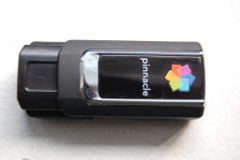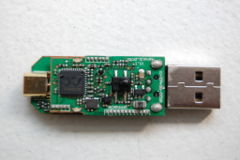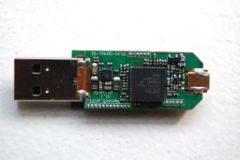Pinnacle PCTV HD Mini Stick (80e): Difference between revisions
No edit summary |
|||
| Line 142: | Line 142: | ||
'''Note''': The patches do not work with current kernels like 2.6-35 due to changes in the surrounding mainline kernel (API breakage). |
'''Note''': The patches do not work with current kernels like 2.6-35 due to changes in the surrounding mainline kernel (API breakage). |
||
In October 2011, Patrick Dickey created a project on Github to clean up the code an apply it to the latest base code at the time. It can be found at: [https://github.com/patrickdickey52761/PCTV80e] The readme has very good information on how to get it to work. |
|||
==External Links== |
==External Links== |
||
Latest revision as of 23:42, 5 January 2013
An ATSC USB 2.0 device by Pinnacle.
It not supported under Linux, although there is now a beta driver which can be found here: [1]. A more up to date driver can be found here: [2]
Overview/Features
An USB TV Tuner that supports 8-VSB and QAM. The unit ships with an IR remote control & telescopic antenna.
Components Used
| Manufacturer | IC Part # | Function | I²C address | GPIO(s) |
|---|---|---|---|---|
| Philips / NXP | TDA18271 C2 | Tuner | 0xc0 | n/a |
| Micronas | DRX 3933J | 8VSB / QAM Digital Demodulator [3] | 0x52 | reset=6 |
| Empia | EM2874 | USB Bridge | n/a | n/a |
| EEPROM | 0xa0 | n/a | ||
| LED | n/a | active=7 |
Identification
USB Subsystem ID is: 2304:023f.
Output of lsusb -v:
Bus 007 Device 003: ID 2304:023f Pinnacle Systems, Inc. [hex]
Device Descriptor:
bLength 18
bDescriptorType 1
bcdUSB 2.00
bDeviceClass 0 (Defined at Interface level)
bDeviceSubClass 0
bDeviceProtocol 0
bMaxPacketSize0 64
idVendor 0x2304 Pinnacle Systems, Inc. [hex]
idProduct 0x023f
bcdDevice 1.00
iManufacturer 1 Pinnacle Systems
iProduct 2 PCTV 80e
iSerial 3 123456789012
bNumConfigurations 1
Configuration Descriptor:
bLength 9
bDescriptorType 2
wTotalLength 41
bNumInterfaces 1
bConfigurationValue 1
iConfiguration 0
bmAttributes 0x80
(Bus Powered)
MaxPower 500mA
Interface Descriptor:
bLength 9
bDescriptorType 4
bInterfaceNumber 0
bAlternateSetting 0
bNumEndpoints 1
bInterfaceClass 255 Vendor Specific Class
bInterfaceSubClass 0
bInterfaceProtocol 0
iInterface 0
Endpoint Descriptor:
bLength 7
bDescriptorType 5
bEndpointAddress 0x84 EP 4 IN
bmAttributes 1
Transfer Type Isochronous
Synch Type None
Usage Type Data
wMaxPacketSize 0x0000 1x 0 bytes
bInterval 1
Interface Descriptor:
bLength 9
bDescriptorType 4
bInterfaceNumber 0
bAlternateSetting 1
bNumEndpoints 1
bInterfaceClass 255 Vendor Specific Class
bInterfaceSubClass 0
bInterfaceProtocol 0
iInterface 0
Endpoint Descriptor:
bLength 7
bDescriptorType 5
bEndpointAddress 0x84 EP 4 IN
bmAttributes 1
Transfer Type Isochronous
Synch Type None
Usage Type Data
wMaxPacketSize 0x03ac 1x 940 bytes
bInterval 1
Device Qualifier (for other device speed):
bLength 10
bDescriptorType 6
bcdUSB 2.00
bDeviceClass 0 (Defined at Interface level)
bDeviceSubClass 0
bDeviceProtocol 0
bMaxPacketSize0 64
bNumConfigurations 1
Device Status: 0x0000
(Bus Powered)
Making It Work
On July 4, 2010, KernelLabs released a beta driver for this device. It is intended to be merged upstream once it has been cleaned up to meet the Linux kernel coding standards. More Information can be found in this blog post: KernelLabs blog
Note: The patches do not work with current kernels like 2.6-35 due to changes in the surrounding mainline kernel (API breakage).
In October 2011, Patrick Dickey created a project on Github to clean up the code an apply it to the latest base code at the time. It can be found at: [4] The readme has very good information on how to get it to work.


